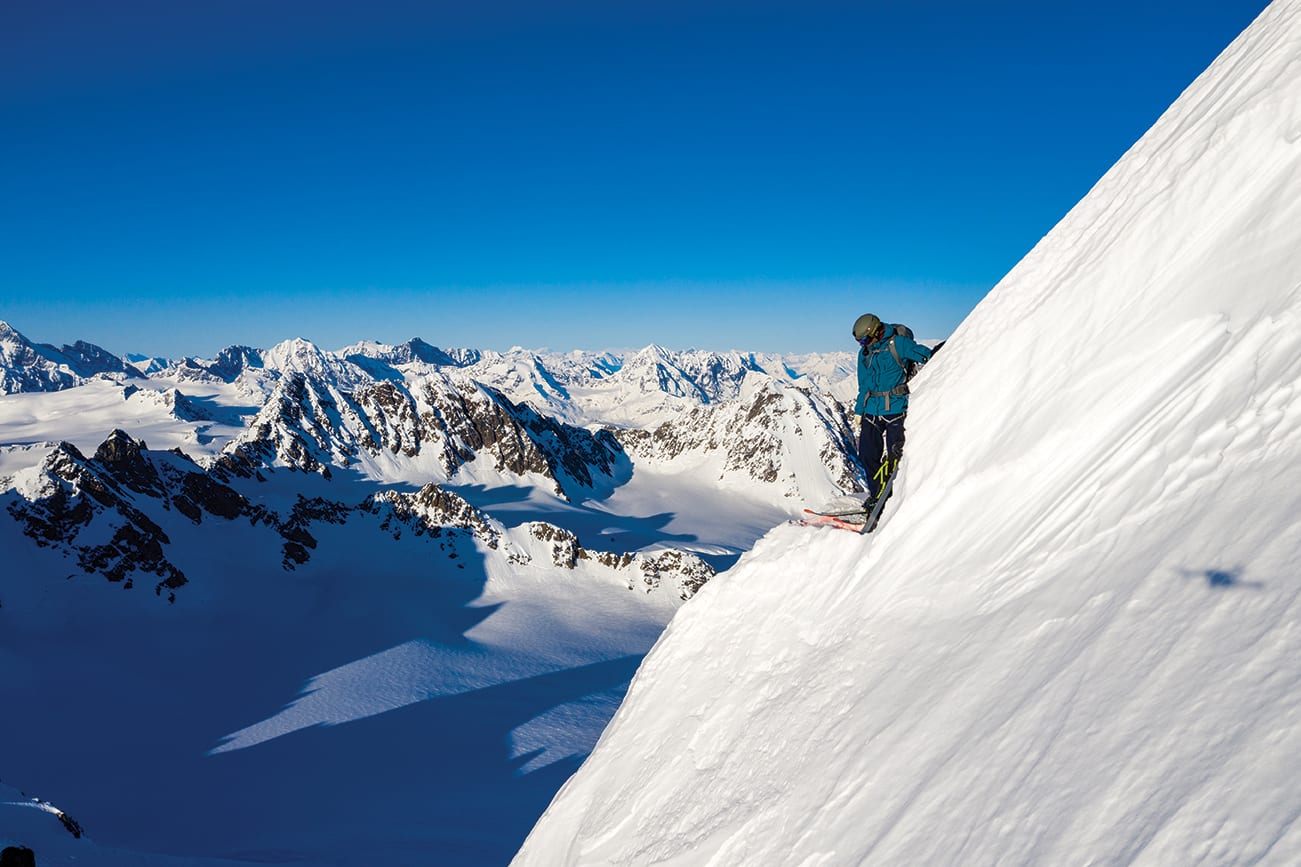
27 Sep Cody Townsend Tackles ‘The Fifty’
After years of filming, the Squaw Valley skier has turned to North America’s most daunting lines for a new adventure
It’s late July, and a tan Cody Townsend takes a sip from a Yeti mug. It couldn’t be further from midwinter, and the nearest skiable patch of snow is hours away, but sitting outside Sugar Pine Cakery on Tahoe’s North Shore, the professional skier from Squaw Valley is all smiles.
He smiles when discussing skiing, snow and the upcoming winter, but that much should be obvious since he’s one of the world’s most famous skiers. But he also flashes a wide grin when discussing what he will make his wife for dinner that evening, and an even wider smile when he makes fun of himself for mistakes he’s made in the mountains and the growing pains of learning how to become a ski mountaineer.
Always humble, always talented, and now, perfectly content. It wasn’t always this way.
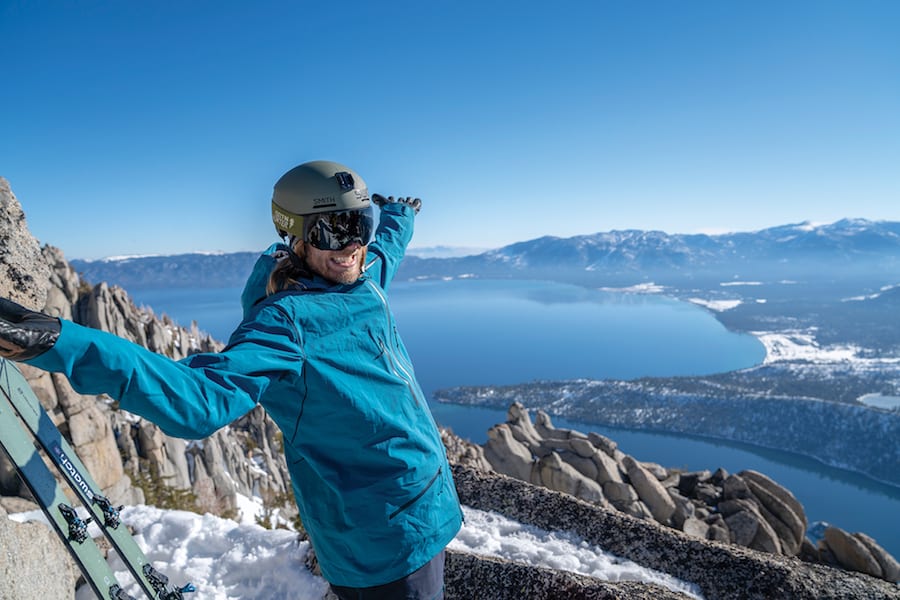
Townsend displays his love for his beautiful home, Lake Tahoe
Pinnacle Achievement
About five years ago, his life was at a crossroads. He had carved out a successful career as a skier by being a grinder, initially working menial jobs around Squaw Valley and sharpening his skills at a resort famous for transforming unknown skiers into known commodities. Along the way, he developed a film career and attracted lucrative sponsors, including Salomon. Steadily, he became more and more relevant, his name developed more cache, and he turned his childhood passion into an adult life in the mountains.
He bought a house in Tahoe and married Elyse Saugstad, also a professional skier. He was in magazines. He was in films. He was a ski star on social media. He had it all, or so it seemed.
A staple in Matchstick Productions films for years, his film career reached its zenith in 2014. The company’s release that year, Days of My Youth, chronicled skiers’ lives and their trajectory toward stardom. To everyone else, it was just another year, just another ski film. But there is one segment in that film that changed Townsend forever. It left him fulfilled, yes, but it also left him directionless for the first time.
In that film, Townsend conquered a career-defining line called “The Crack” in Alaska’s Tordrillo Range. The jaw-dropping descent, which has several million views on YouTube, showered him with unprecedented praise. Professionally speaking, none of the accolades were bigger than the “Best Line” and “Full Throttle” awards given to him by POWDER magazine, the industry’s most respected publication.
In short, a former high school quarterback from Santa Cruz, a town famous for surfing, was considered the best skier in the world. In the world. Everyone—friends, family, sponsors, critics—wanted to know what Townsend would do for an encore, as is the nature of the ski industry. Even Townsend was curious about what was next. But he had no answers for himself or anybody else, only questions.
“It all starts with The Crack, because after I did that, it had me feeling a little burnt out on the ski film production stuff,” Townsend says. “I had been doing that for 10 years and got to this point of doing everything I had wanted to do, every goal. My last dream was an explicit dream and that was The Crack and skiing something like that—and I had found it and skied it.
“So that summer everybody was asking me, ‘What is next?’ I had no idea. People were putting pressure on me and were telling me, ‘How are you going to top that? You have to do something.’ I did the opposite. I pulled back.”
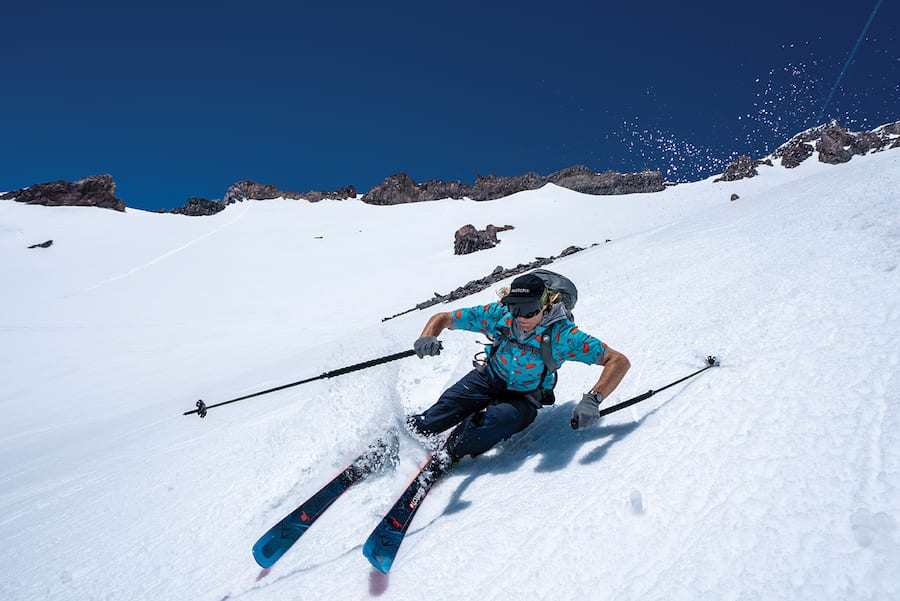
Townsend skis perfect corn snow on Mount Shasta in his favorite Hawaiian shirt
A New Direction
Inexplicably, at least to the outside world, Townsend stopped filming. He ditched the helicopter and replaced it with his own feet. He traded guaranteed powder for uncertain snow conditions. He went on his first expedition-style trip, skiing and climbing big, steep lines in remote places where only he and a few friends were witnesses. He went on trips as close as the Eastern Sierra and as far away as Tibet. He found immense pleasure being in the mountains without an orchestrated film crew. It’s not that he felt the non-commercial aspect was better than the commercial one. It’s just that the 36-year-old had noticed a change within himself that made him appreciate a new style of mountain adventure.
“I found I had other dreams, and those trips changed my perspective of the mountains in general and my relationship with the mountains,” Townsend says. “That is when I started to figure out that the typical ski film production, what I had been doing out of a helicopter, my heart wasn’t there anymore. One of my biggest fears in life is turning something that I love into a job and something I resent. I started to get to that point. And if I kept doing what I was doing, then I was going to not like this sport anymore—and to me that was a tragedy to turn the thing that guided my whole life, the thing I loved most, into a job…

Pontoon Peak is one of two classic ski descents in Alaska that Townsend checked off his list
“I knew from a career perspective that it was going to be bad, that I would go through the motions and be bitter at the end. So I started searching for something else and found it by climbing and skiing for my own lines.”
Townsend has been most fond of skiing peaks in North America, particularly Alaska, and he had casually thumbed through a book over the years entitled Fifty Classic Ski Descents of North America. Published in 2011, it’s an unscientific collection of the 50 iconic lines on the continent, compiled and written by the most reliable scientists to produce such a list: the leading skiers of current and former generations who have intimate knowledge of the peaks featured. Among them: acclaimed ski mountaineer Chris Davenport.
Suddenly, Townsend had a new dream that he labeled, simply, “The Fifty.” Starting last winter, his goal was to become the first skier in history to ski all 50 lines in the book. As of this printing, Townsend has completed 20 of the 50 lines and hopes to complete the rest over the next two winters.
“I think it’s a pretty crazy list to accomplish if you’re a fairly accomplished ski mountaineer, which, Cody will be the first to tell you, he isn’t,” says Chris Rubens, Townsend’s friend and a fellow freeskier based out of Canada. “He’s had to learn a lot of new stuff to do this. For him to boldly take on such a project is definitely ballsy. Not that I don’t think Cody understands how difficult it is, or that I don’t think he is good enough—there is just a fairly likely chance that he can’t pull it off.”
Townsend has always been a confident and determined man, but in many ways he’s a reborn man. He can attribute that to a coffee-table book that scares readers as much as it inspires them. For a skier, to climb and ski one of the peaks in the book is a life well lived. But to climb and ski all 50 of the lines—some of which have only been skied once—seemed a preposterous objective.
“I had the book for a long time, would flip through it here and there, but it didn’t have great meaning to me,” Townsend says. “But once I started going on these trips it started to have more meaning to me. Looking at the book once I knew more about that type of skiing, it appealed to me and I started to realize why nobody has ever done all 50… it’s pretty gnarly stuff.”
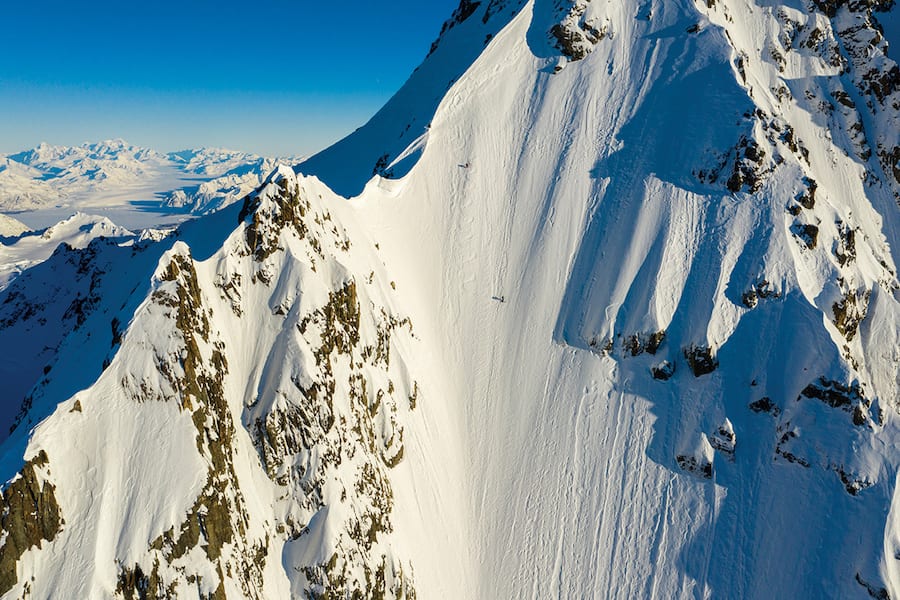
Townsend and Salén ski Sphinx in Alaska, thanks to a lift by Points North Heli-Adventures to the base of the famous peak
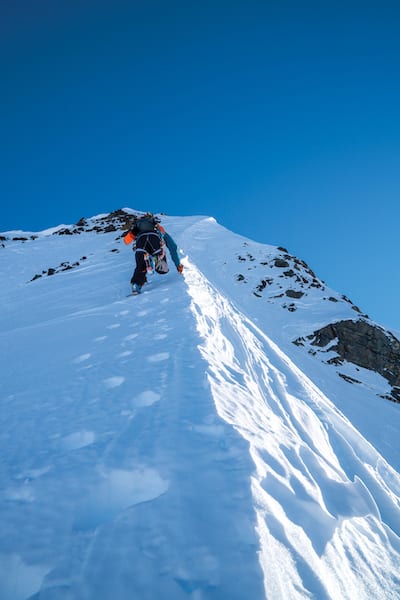
Climbing the steeps of Sphinx
The Fifty
Although he’s distanced himself from the mainstream ski film industry, Townsend has turned The Fifty into a popular web series on YouTube. Each peak comes with its own episode. He has friends or colleagues document his trips, and he has creative control over the production side of it. Townsend has never been one to take himself too seriously. After all, one of his mentors was professional jokester and Squaw legend Shane McConkey, whose off-the-hill antics and behavior could only be overshadowed by his on-the-hill accomplishments. (McConkey died in 2009 while ski BASE jumping in Italy.)
“I kept thinking about it and thinking about how I could fit this into my career,” Townsend says. “I knew I needed some media component, but a movie wouldn’t work mainly because there are only two outcomes: success or failure. And a movie takes a year to make and I didn’t want that to be the story, failing or succeeding, because I know that there is a really good chance that I will fail. That wouldn’t be a good movie.
“So I have tried to keep the content on everything that goes into climbing and skiing one of these peaks, and stay away from the skiing itself. Sometimes it works and sometimes it doesn’t, but it’s been to bring a creative side to this and have some fun with it. Eighty percent of each episode isn’t about skiing.”
By the time he began theorizing about the project in 2017, he had already climbed several of the peaks in the book: Mount Shasta in Northern California, Mount Superior in Utah, Terminal Cancer Couloir in Nevada’s Ruby Mountains and Bloody Couloir outside Mammoth Lakes in the Eastern Sierra. He planned to repeat those routes once he launched the project. The only peak he had done previously that he won’t repeat is the vaunted Messner Couloir on Denali, the highest point in North America at 20,310 feet. Townsend considers himself lucky to have safely descended the route, which has been the site of fatal accidents in the past. (He made his first web series episode on the Messner Couloir.)
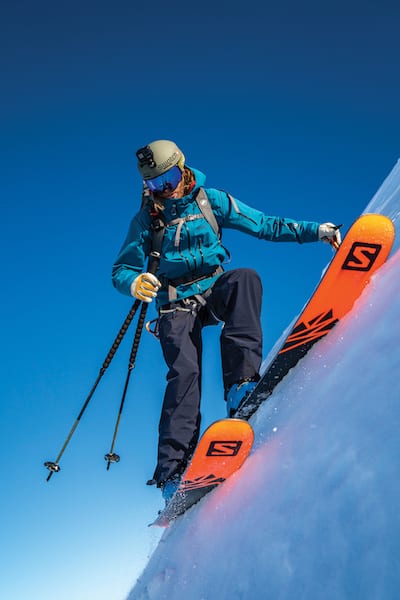
On edge on Sphinx
Once he started visiting other peaks in the book and learned about them, he quickly realized he couldn’t enter the project by dipping his toes into the water. He’d have to jump fully in or risk certain failure. He had to get his wife’s blessing, because, “Well, it’s pretty dangerous and there’s no way I could do it without her giving me permission. And she did.”
At that point, Townsend’s life’s compass was recalibrated, and he found the direction he was missing.
“Many of us have been at those points in our careers, where we’ve done the traditional ski porn stuff and you’re just not willing to put your body at risk and huck your meat off cliffs and compete with younger guys… that stuff isn’t important anymore,” Rubens says. “We’ve experienced that portion of this sport and I think many people progress into the ski mountaineering side of things. Instead of the little highs you get for five minutes after skiing a big line for a camera, you build up bigger highs on these big projects that last longer.”
To prepare for each peak, Townsend spends hours, days, weeks, even months, studying maps, trip reports and avalanche reports from the zones that encompass these 50 peaks. He doesn’t focus on trip reports as much as patterns of when each route has been skied during the year. Some peaks, including the “three cruxes,” as Townsend confides, will require a combination of timing and luck to pull off.
Townsend typically tries to do lines in the lower 48 states early season and midwinter, then bigger lines in Alaska in the spring when conditions are usually best. At a moment’s notice, though, he has driven his truck across the Great Basin to climb a peak because conditions were favorable. This winter, the most difficult lines he plans to ski include Alaska’s Mount Saint Elias, the fourth highest peak in North America at 18,008 feet, and University Peak, also in Alaska.
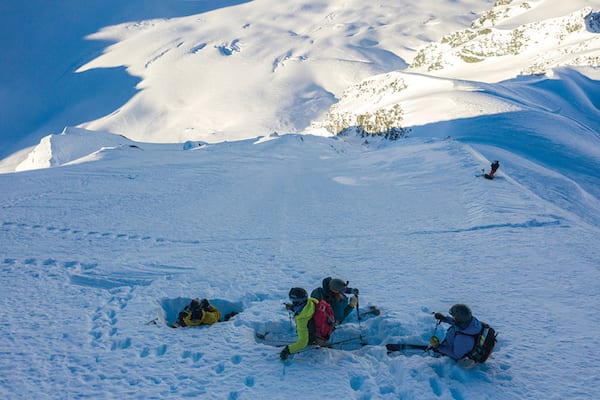
Townsend, Ming Poon, Brennan Lagasse and Jeff Dostie prepare to drop into Pontoon for The Fifty project, as Bjarne Salén films from below
“You have to remember, some of these are lifetime achievements to do one of them,” says Tahoe-based photographer Ming Poon, who has accompanied Townsend on a few of his climbs. “Honestly, there is a lot of luck involved with what Cody is trying to accomplish. But he is so fit, so prepared, so intelligent, so willing to do the work, that if anybody can do it, Cody can do it. But he’s smart enough to know not to force it. He knows that if he forces it, if he rolls the dice too many times with the odds, it could be dangerous. He’s smart enough to fail before that happens.”
The three cruxes, in Townsend’s mind, are Mount Robson in the Canadian Rockies, Mount St. Elias, which boasts the largest vertical drop from summit to base in the world, and University Peak in the same range as Mount St. Elias—an area 35 miles from the Gulf of Alaska that is notorious for frequent, violent storms. Of the three cruxes, there is no disagreement which one is the hardest, scariest and least likely to attract partners for Townsend: University Peak.
University Peak’s south face drops more than 7,500 feet on a slope with a consistent pitch of 50 to 55 degrees toward the glacier below. On any of the more serious peaks, weather is a constant concern, but there is also yawning exposure that creates a situation where, “You fall, you die.”

Townsend climbs and skis Mount Shasta with a local friends crew consisting of Scott Gaffney, Megan Michelson, Michelle Parker, Brennan Lagasse, Jeff Dostie, Kyle O’Neal and Bjarne Salén
“When creating this list, we really wanted to have a broad variety of mountains,” says Davenport, who co-authored Fifty Classic Ski Descents of North America with Art Burrows and Penn Newhard “… Really easy green runs, if you will, some more challenging ones, and then some aspirational ones that might not ever get repeated again. Like the north face of Robson or University, these are freaks of nature. Those are the cruxes for a project like this. It’s all about timing and there might only be a few days a year those are in condition, if at all. So I think the project is not without its inherent risks on some of these biggest mountains. Having a good risk averse mindset, when to turn around, that’s important.
“I like the way Cody is having fun with it and approaching with humility, in many ways not taking it too seriously and letting the peaks come to him. Certainly there are other ski mountaineers that have the skill set to ski all of these things, but to take on the project and claim that’s what you’re doing, you need someone with the experience, the wherewithal, the funding, the skills, and that’s why someone like Cody can pull it off.”
As much as he wants to attempt and successfully climb and ski all 50 peaks, Townsend has proven to himself that he has the experience and maturity to turn around if something isn’t right. He did that with one of Alaska’s iconic lines, Pontoon Peak. He wasn’t feeling it that day and retreated, only to return and climb and ski it later that winter. Paradoxically, it’s the peaks he didn’t climb that give him confidence to climb the peaks he doesn’t think he can.
“I can turn around and fail. I am OK with that,” Townsend says. “I have turned around and made the right decision before, and doing that gives me confidence. I am constantly learning and getting better with using an ice axe and all of that. It’s fun. I’ve had to ski on some really bad snow, and I have met some really nice people and seen some cool places. I am enjoying myself whether I ski them all or not.”
Jeremy Evans is a South Lake Tahoe–based author who’s working on his third book, See You Tomorrow, which is about snowboarder Marco Siffredi’s mysterious disappearance on Mount Everest in 2002. The book will be released in 2021. For more information, visit www.jeremyevans.org.




No Comments